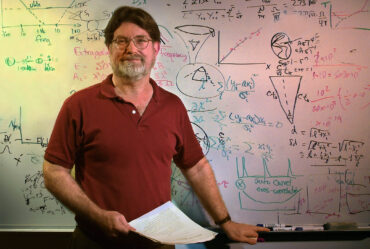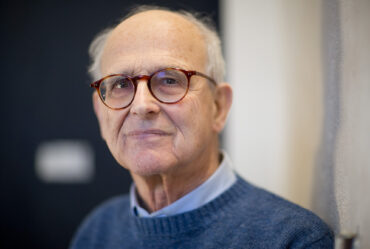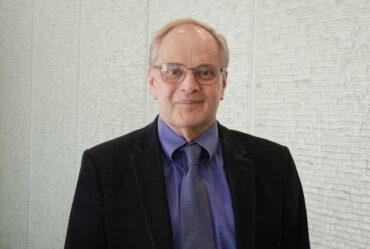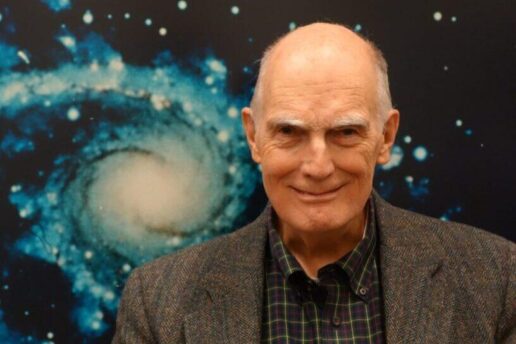
Hale Van Dorn Bradt PhD ’61, professor emeritus and X-ray astronomy pioneer, dies at 93
Longtime MIT faculty member used X-ray astronomy to study neutron stars and black holes and led the All-Sky Monitor instrument on NASA’s Rossi X-ray Timing Explorer
Professor of Physics Emeritus Hale Van Dorn Bradt PhD ’61 of Peabody, formerly of Salem and Belmont, beloved husband of Dorothy A. (Haughey) Bradt, passed away on Thursday, November 14, 2024, at Salem Hospital, surrounded by his loving family. He was 93.
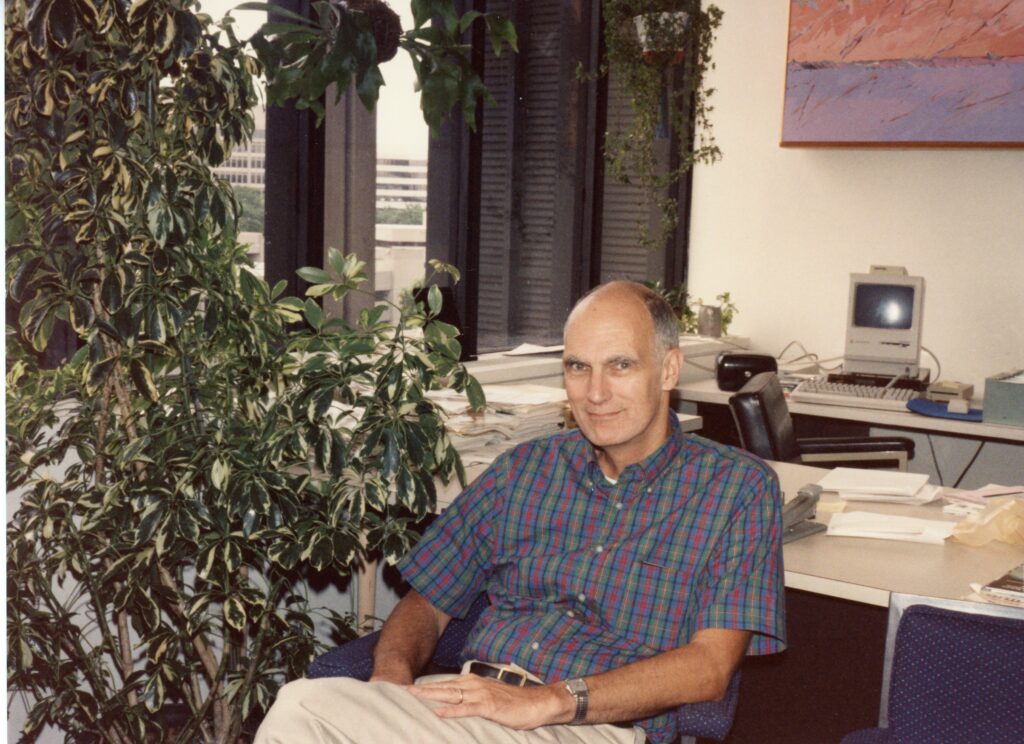
Bradt worked primarily in X-ray astronomy with NASA rockets and satellites, studying neutron stars and black holes in X-ray binary systems using rocket-based and satellite-based instrumentation. He was the original principal investigator for the All-Sky Monitor instrument on NASA’s Rossi X-ray Timing Explorer (RXTE), which operated from 1996 to 2012.
Much of his research was directed toward determining the precise locations of celestial X-ray sources, most of which were neutron stars or black holes. This made possible investigations of their intrinsic natures at optical, radio, and X-ray wavelengths.
“Hale was the last of the cosmic ray group that converted to X-ray astronomy,” says Bruno Rossi Professor of Physics Claude Canizares. “He was devoted to undergraduate teaching and, as a postdoc, I benefited personally from his mentoring and guidance.”
He shared the Bruno Rossi Prize in High-Energy Astrophysics from the American Astronomical Society in 1999.
Bradt earned his PhD at MIT in 1961, working with advisor George Clark in cosmic ray physics, and taught undergraduate courses in physics from 1963 to 2001.
In the 1970s, he created the Department’s undergraduate astrophysics electives 8.282 and 8.284, which are still offered today. He wrote two textbooks based on that material, Astronomy Methods (2004) and Astrophysics Processes (2008), the latter which earned him the 2010 Chambliss Astronomical Writing Prize of the American Astronomical Society (AAS).
Son of a Musician and Academic
Born on December 7, 1930, to Wilber and Norma Bradt in Colfax, Washington, he was raised in Washington State, as well as Maine, New York City, and Washington, D.C., where he graduated from high school.
His mother was a musician and writer, and his father was a chemistry professor at the University of Maine who served in the Army during World War II.
Six weeks after Wilber Bradt returned home from the war, he took his own life. Hale Bradt was 15. In 1980, Hale discovered a stack of his father’s personal letters written during the war, which led to a decades-long research project that took him to the Pacific islands where his father served. This culminated with the book trilogy Wilber’s War, which earned him two silver awards from the IBPA’s Benjamin Franklin and Foreword Reviews’ IndieFAB; he was also an award finalist from National Indie Excellence.
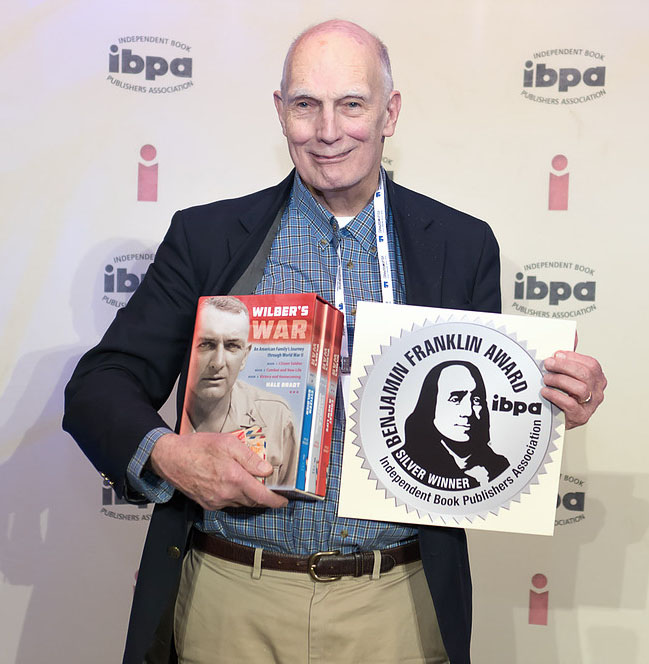
Hale discovered his love of music early; he sang in the Grace Church School choir in fifth and sixth grades, and studied the violin from the age of 8 until he was 21. He studied musicology and composition at Princeton, where he played in the Princeton Orchestra. He also took weekly lessons in NYC with one of his childhood teachers, Irma Zacharias, who was the mother of MIT professor Jerrold Zacharias. “I did not work at the music courses very hard and thus did poorly,” he recalled.
In the 1960s, at MIT he played with a string quartet that included MIT mathematicians Michael Artin, Lou Howard, and Arthur Mattuck. Bradt and his wife, Dottie, also sang with the MIT Chorale Society from about 1961–71, which included a 1962 trip to Europe.
Well into his 80s, Bradt retained an interest in classical music, both as a violinist and as a singer, performing with diverse amateur choruses, orchestras, and chamber groups. At one point he played with the Belmont Community Orchestra, and sang with the Paul Madore Chorale in Salem. In retirement, he and his wife enjoyed chamber music, opera, and the Boston Symphony Orchestra.
In the Navy
In the summer before his senior year he began Naval training, which is where he discovered a talent for “mathematical-technical stuff,” he said. “I discovered that on quantitative topics, like navigation, I was much more facile than my fellow students. I could picture vector diagrams and gun mechanisms easily.”
He said he came back to Princeton “determined to get a major in physics,” but because that would involve adding a fifth year to his studies, “the Dean wisely convinced me to get my degree in music, get my Navy commission, and serve my two years.” He graduated in 1952, trained for the Navy with the Reserve Officer Candidate program, and served in the US Navy as a deck officer and navigator on the USS Diphda cargo ship during the Korean War.
MIT Years
He returned to Princeton to work in the Cosmic Ray lab, and then joined MIT as a graduate student in 1955, working in Bruno Rossi’s Cosmic Ray Group as a research assistant. Recalls Bradt, “The group was small, with only a half-dozen faculty and a similar number of students. Sputnik was launched, and the group was soon involved in space experiments with rockets, balloons, and satellites.”
The beginnings of celestial X-ray and gamma-ray astronomy took root in Cambridge, as did the exploration of interplanetary space. Bradt also worked under Bill Kraushaar, George Clark, and Herbert Bridge, and was soon joined by radio astronomers Alan Barrett and Bernard Burke, and theorist Phil Morrison.
While working on his PhD thesis on cosmic rays, he took his measuring equipment to an old cement mine in New York State, to study cosmic rays that had enough energy to get through the 30 feet of overhead rock.
As a professor, he studied extensive air showers with gamma-ray primaries (as low-mu showers) on Mt. Chacaltaya in Bolivia, and in 1966, he participated in a rocket experiment that led to a precise celestial location and optical identification of the first stellar X-ray source, Scorpius X-1.
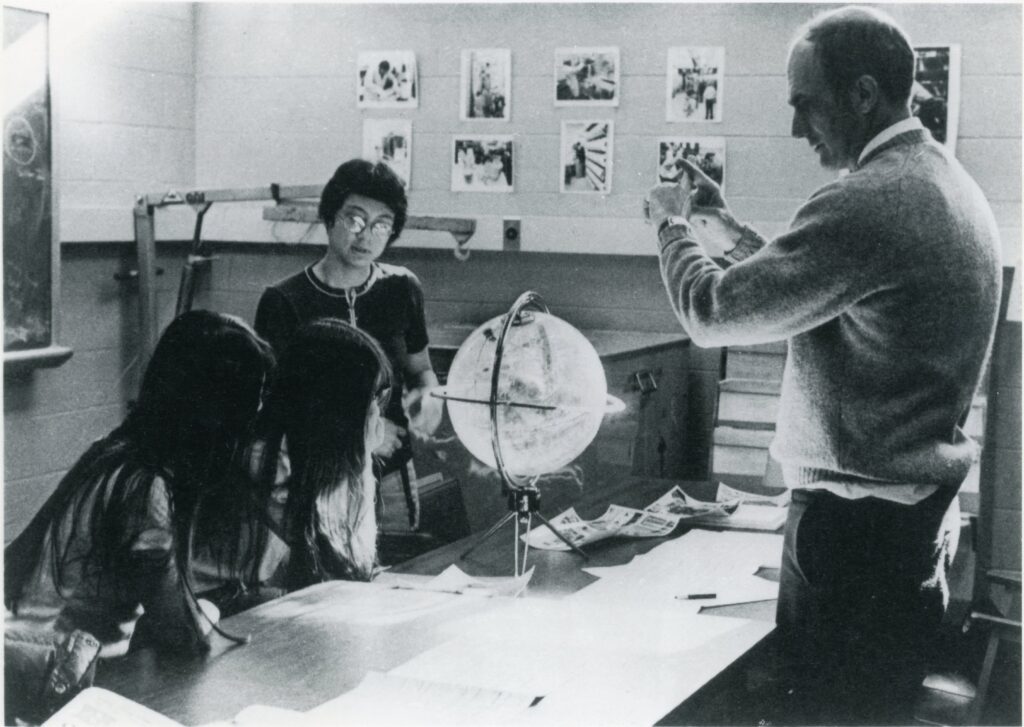
“X-ray astronomy was sort of a surprise,” said Bradt. “Nobody really predicted that there should be sources of X-rays out there.”
His group studied X-rays originating from the Milky Way Galaxy by using data collected with rockets, balloons, and satellites. In 1967, he collaborated with NASA to design and launch sounding rockets from White Sands Missile Range, which would use specialized instruments to detect X-rays above Earth’s atmosphere.
Bradt was a senior participant or a principal investigator for instruments on the NASA X-ray astronomy satellite missions SAS-3 that launched in 1975, HEAO-1 in 1977, and RXTE in 1995.
All Sky Monitor and RXTE
In 1980, Bradt and his colleagues at MIT, Goddard Space Flight Center, and the University of California at San Diego began designing a satellite that would measure X-ray bursts and other phenomena on time scales from milliseconds to years. By 1995, the team launched RXTE.
Until 2001, Bradt was the principal investigator of RXTE’s All Sky Monitor, which scanned vast swaths of the sky during each orbit. When it was decommissioned in 2012, the RXTE provided a 16-year record of X-ray emissions from various celestial objects, including black holes and neutron stars. The 1969 sounding rocket experiment by Bradt’s group discovered X-ray pulsations from the Crab pulsar, which demonstrated that the X-ray and optical pulses from this distant neutron star arrived almost simultaneously, despite traveling through interstellar space for thousands of years.
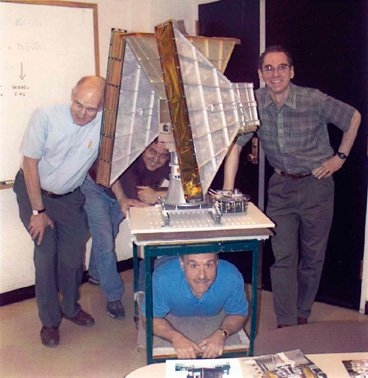
He received NASA’s Exceptional Scientific Achievement Medal in 1978 for his contributions to the HEAO-1 mission and shared the 1999 Bruno Rossi Prize of the American Astronomical Society’s High Energy Astrophysics Division for his role with RXTE.
“Hale’s work on precision timing of compact stars, and his role as an instrument PI on NASA’s Rossi X-ray Timing Explorer played an important part in cultivating the entrepreneurial spirit in MIT’s Center for Space Research, now the MIT Kavli Institute,” says Rob Simcoe, the Francis L. Friedman Professor of Physics and Director of the MIT Kavli Institute for Astrophysics and Space Research.
Without Bradt’s persistence, the HEAO 1 and RXTE missions may not have launched, recalls Alan Levine PhD ’76, a principal research scientist at Kavli who was the project scientist for RXTE. “Hale had to skillfully negotiate to have his MIT team join together with a (non-MIT) team that had been competing for the opportunities to provide both experimental hardware and scientific mission guidance,” he says. “The A-3 experiment was eventually carried out as a joint project between MIT under Hale and Harvard/Smithsonian under Herbert (Herb) Gursky.”
“Hale had a strong personality,” recalled Levine. “When he wanted something to be done, he came on strong and it was difficult to refuse. Often it was quicker to do what he wanted rather than to say no only to be asked several more times and have to make up excuses.”
“He was persistent,” agreed former student, Professor of Physics Emeritus Saul Rappaport PhD ’68. “If he had a suggestion, he never let up.”
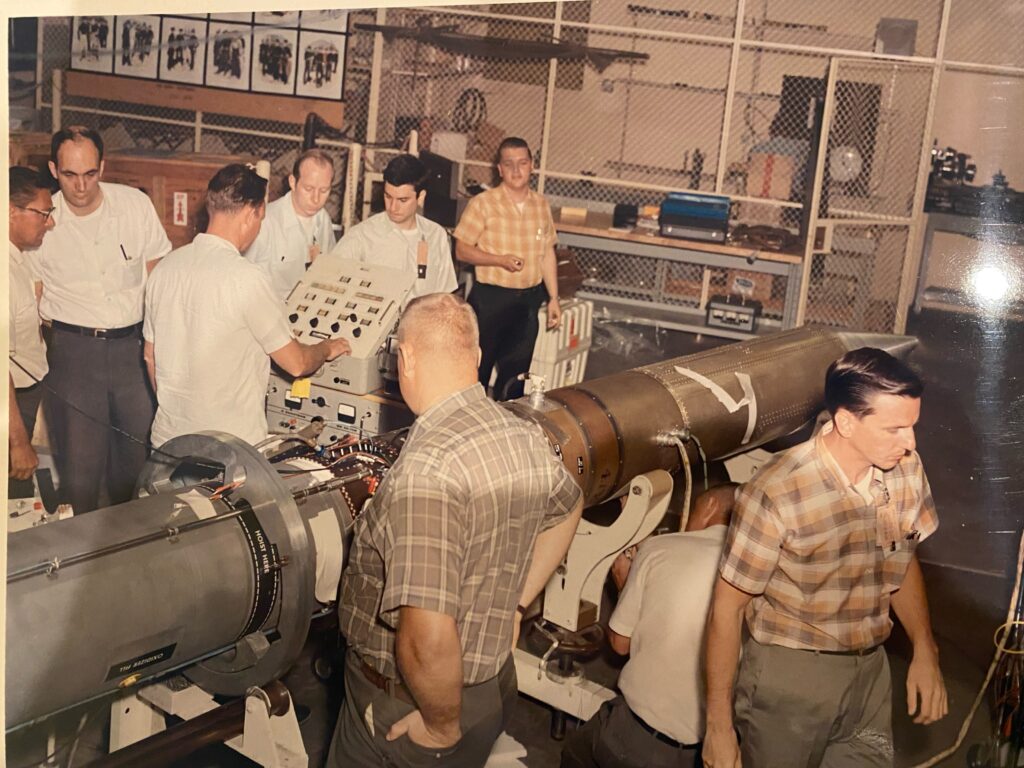
Rappaport also recalled Bradt’s exacting nature. For example, for one sounding rocket flight at White Sands Missile Range. “Hale took it upon himself to be involved in every aspect of the rocket payload, including parts of it that were built by Goddard Space Flight Center – I think this annoyed the folks at GSFC,” recalled Rappaport. “He would be checking everything three times. There was a famous scene where he stuck his ear in the (compressed-air) jet to make sure that it went off, and there was a huge blast of air that he wasn’t quite expecting. It scared the hell out of everybody, and the Goddard people were, you know, a bit amused. The point is that he didn’t trust anything unless he could verify it himself.”
Supportive Advisor
Many former students recalled Hale’s supportive teaching style, which included inviting MIT students over to their Belmont home, and was a strong advocate for his students’ professional development.
“He was a wonderful mentor: kind, generous, and encouraging,” recalls Physics Department Head and Professor Deepto Chakrabarty ’88, who had Bradt as his postdoctoral advisor when he returned to MIT in 1996.
“I’m so grateful to have had the chance to work with Hale as an undergraduate,” recalls UCLA Professor and Nobel laureate Andrea Ghez ‘87. “He taught me so much about high-energy astrophysics, the research world, and how to be a good mentor. Over the years, he continuously gave me new opportunities — starting with working on on-board data acquisition and data analysis modes for the future Rossi X-Ray Timing Explorer with Ed Morgan and Al Levine. Later, he introduced me to a project to do optical identification of X-ray sources, which began with observing with the MIT-Michigan-Dartmouth Telescope (MDM) with then-postdoc Meg Urry and him.”
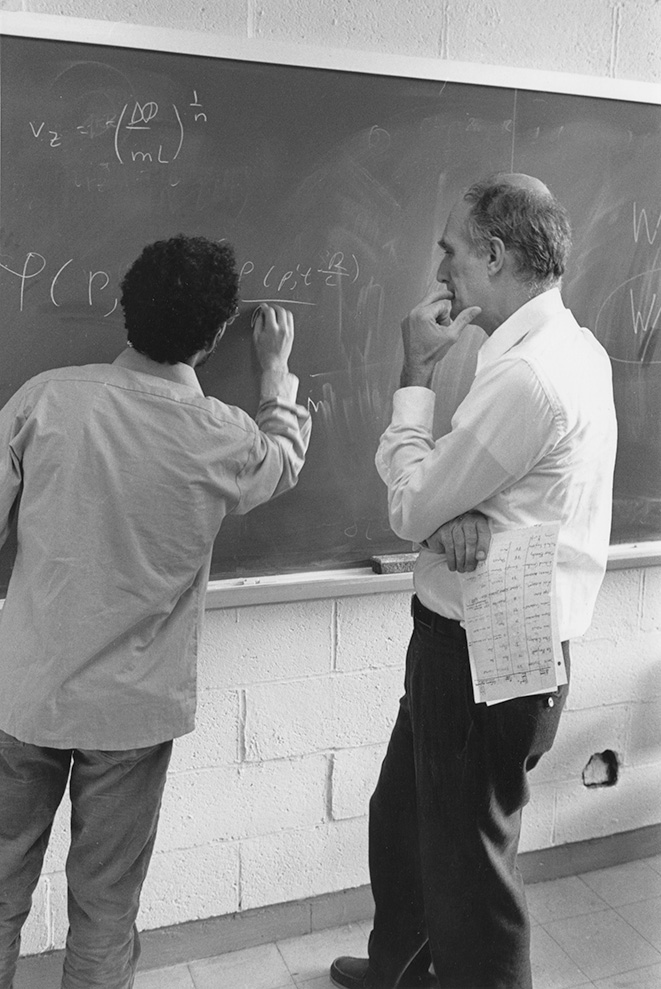
Bradt was a relatively new professor when he became Saul Rappaport’s advisor in 1963. At the time, MIT was switching from the study of cosmic rays to the new field of X-ray astronomy. “Hale turned the whole rocket program over to me as a relatively newly minted PhD, which was great for my career, and he went on to some satellite business, the SAS 3 satellite in particular. He was very good in terms of looking out for the careers of junior scientists with whom he was associated.”
Bradt looked back on his legacy at MIT Physics with pride. “Today, the astrophysics division of the department is a thriving community of faculty, postdocs, and graduate students,” Bradt said recently. “I cast my lot with X-ray astronomy in 1966 and had a wonderfully exciting time observing the X-ray sky from space until my retirement in 2001.”
After retirement, Bradt served for 16 years as academic advisor for MIT’s McCormick Hall first-years. He received MIT’s Buechner Teaching Prize in Physics in 1990, Outstanding Freshman Advisor of the Year Award in 2004, and the Alan J. Lazarus (1953) Excellence in Advising Award in 2017.
Recalled Ghez, “He was a remarkable and generous mentor and helped me understand the importance of helping undergraduates make the transition from the classroom to the wonderfully enriching world of research.”
Post-retirement, Bradt transitioned into Department historian and mentor.
“I arrived at MIT in 2003, and it was several years before I realized that Hale had actually retired two years earlier – he was frequently around and always happy to talk with young researchers,” says Simcoe. “In his later years, Hale became an unofficial historian for CSR and MKI, providing first-hand accounts of important events and people central to MIT’s contribution to the ‘space race’ of the mid-20th century, and explaining how we evolved into a major center for research and education in spaceflight and astrophysics.”
To read more about the making of the Rossi X-ray Timing Explorer mission, see Hale Bradt’s book “Chasing Black Holes: An Insider’s View of a Space Astronomy Mission (RXTE)” at https://bit.ly/ChasingBlackHolesPDF.
Bradt’s other recognitions include earning a 2015 Darius and Susan Anderson Distinguished Service Award of the Institute of Governmental Studies, and a 1978 NASA Exceptional Scientific Achievement Medal, and being named a 1972 American Physical Society Fellow and 2020 AAS Legacy Fellow.
Bradt served as secretary-treasurer (1973–75) and chairman (1981) of the AAS High Energy Astrophysics Division, and on the National Academy of Science’s Committee for Space Astronomy and Astrophysics from 1979 to 1982. He recruited many of his colleagues and students to help him host the 1989 meeting of the American Astronomical Society in Boston, a major astronomy conference.
In retirement, Bradt has also worked as a longtime volunteer caretaker for the historical Almy’s clock in downtown Salem. He also played a part in the clock’s restoration, which was reinstalled on December 20th.
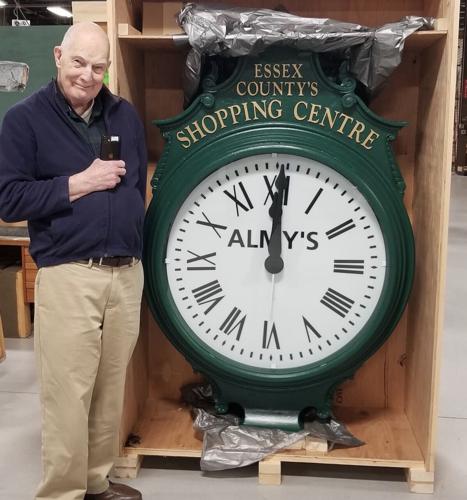
The son of the late Lt. Col. Wilber E. Bradt and Norma Sparlin Bourjaily, and brother of the late Valerie Hymes of Annapolis, MD, he is survived by his wife, Dorothy Haughey Bradt, whom he married in 1958; two daughters and their husbands, Elizabeth Bradt and J. Bartlett “Bart” Hoskins of Salem, MA, and Dorothy and Bart McCrum of Buxton, ME; two grandchildren, Benjamin and Rebecca Hoskins; two other sisters, Abigail Campi of St. Michael’s, MD, and Dale Anne Bourjaily of the Netherlands, and 10 nieces and nephews.
In lieu of flowers, contributions may be made to the Salem Athenaeum, or the Thomas Fellowship.
Hale established the Thomas Fellowship in memory of Barbara E. Thomas, who was the Department of Physics undergraduate administrator from 1931 to 1965, as well as to honor the support staff who have contributed to the Department’s teaching and research programs.
“MIT has provided a wonderful environment for me to teach and to carry out research,” said Bradt. “I am exceptionally grateful for that and happy to be in a position to give back.” He added, “Besides, I am told you cannot take it with you.”
The Barbara E. Thomas Fund in support of physics graduate students has been established in the MIT Department of Physics. You may contribute to the fund (#3312250) online at the MIT web site giving.mit.edu, by selecting “Give Now,” then “Physics.” For more information about this fund, other physics funds and naming opportunities in the department, please contact Erin McGrath Tribble, Senior Director of Development for the Department of Physics at (617) 452-2807 or emcgrath@mit.edu.
